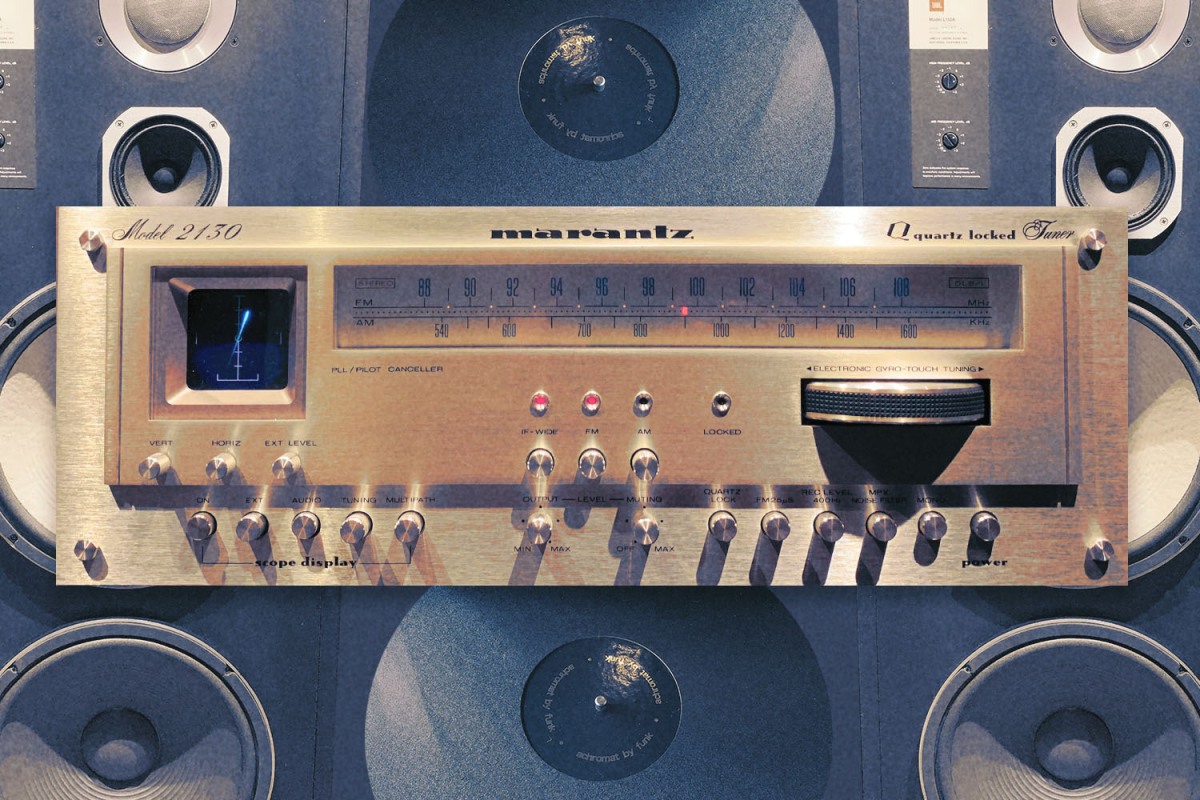Music
Vehicles
Music
Vehicles
To hear the experts tell the tale, there was an unusual confluence of events in the early ‘70s that led to a truly golden era in home audio. Music was having a moment. There was a post-Woodstock bounty of arena-packing rock, soul, and funk – not to mention prog and jazz fusion – that had the youth of America in its thrall. The Baby Boomers were in college and they had access to disposable income, gobbling up records and music magazines with abandon.
According to Andy Zimmerman, owner of Saturday Audio Exchange in Chicago, awareness of higher-quality products was also growing, in part due to GIs coming back from Vietnam who had been exposed to excellent Japanese systems like Marantz, Pioneer, Sansui and Kenwood. They brought home gear from the PX and an understanding of what was missing in the U.S. market, and they created stateside demand for better stereos. There was much more to audio, they realized, than the console that was sitting in most family living rooms. Technological advances were also taking place, like improvements in amplification, the rising popularity of the portable cassette tape, noise reduction and better turntables (for much more on the tech, if you are so inclined, check out this excellent article). Albums were recorded better and featured creative use of multi-tracking, synthesizers and a wide array of effects. The Boomers needed systems to play all this dynamic music that was being released, and the economic conditions existed to light a flame under the audio industry like never before.
And so, in a nutshell, the market at the time was massive and much of the equipment was well built and well cared for. As a result, a lot of this gear never went away — it exists in shops like Zimmerman’s, on eBay, at garage sales and in your relatives’ basements.
Fast forward to the ‘90s and 2000s, and a very different confluence of trends was happening. The consumer’s focus had gradually been shifting from purely audio systems to video systems with theater-style sound. People wanted surround sound for their video players (and later, streaming services) and home audio was firmly moored to the TV set rather than a receiver or integrated amplifier. On a parallel path, audio players were getting more compact (again, thanks to technology) and small home systems like Bose caught attention and gained market share. It was a big sound in a small box. Unfortunately, these systems, while innovative in ways, weren’t really geared toward the audio connoisseur. Eventually, people began to realize that something important had been lost along the way. Maybe that soundbar in the living room didn’t actually sound so great when employed to play your favorite band and move you to feel songs in your bones and soul. In addition to wanting to get better sound, there was something alluring about the tangible and delicate nature of vinyl, and the moribund format made a huge comeback that’s still going strong. Perhaps, a step backward was needed in order to move forward.
Vintage audio has been sought after for more than a decade. But now the market is booming, with top brands like McIntosh, Marantz and Fisher commanding high sticker prices in the thousands of dollars and subreddits and social networks buzzing with excitement and commerce. Even “Chevrolet”-type models like Sherwood can command a high dollar.
“It’s millennials paying for the aesthetic or wanting to re-create their parents’ system,” says Zimmerman. “And it’s an AARP member saying ‘I had this when I was 14 years old.’”
Supply chain issues and the pandemic-induced return to home nesting likely factored into the heightened interest as well, as they impacted other purchasing habits in the past couple of years.
For Mat Bonnette, a barber by day and father of three who has long collected and personally restored dozens of vintage units (Mat is a trained engineer experienced with electronics; laypeople should not attempt for safety reasons), it’s no surprise that people are flocking to these relics. “The ‘50s and ‘60s stuff is so cool. The wood cabinetry. I actually take the covers off [sometimes] so you can see the tubes. They’re interesting to listen to. You can get beautiful JBL [speakers] that will shake the house. And there’s ugly things that do great things.” In addition, he notes, there’s a re-use side of the story that’s compelling. “There’s so much [great stuff already] out there, why add to the crap?” Indeed, the current cultural interest in re-use and eschewing the overtly disposable product no doubt plays a part.
Your one-stop shop in DFW
For my part in the story, as Zimmerman says, “just look in the mirror if you want to see my customer.” I grew up sitting in front of my dad’s Fisher 500C staring at the glow of the dial and feeling the warmth of its tubes when I reached above it for Beatles or Miles Davis albums to play. When I got a little older, I scrimped to buy a Sansui tube receiver that blared Zeppelin and Rush albums throughout my adolescence. I had a Garrard turntable that I picked up from my uncle and Infinity speakers occasionally augmented by a pair of 1960s-era Wharfedale speakers permanently “borrowed” from my dad.
For me, it was definitely about the aesthetics as well as the sound. And it still is, as I’ve recently tried to recreate my childhood system. It’s not an expensive package; I’m probably at about $800 between the receiver (this time a Sansui 331), turntable (modern Music Hall), and speakers (those same Wharfedales). Records are my go to, and they sound phenomenal.
“These systems were designed around vinyl,” says Zimmerman. “They are typically warmer sounding, and even the cheaper models weren’t bad.” Agreed on that. And the quality of vinyl playback didn’t stop me from patching in a top-loading TEAC cassette player recently so that I can revel in the mix tapes I kept since high school. “You might need a cassette player to play those Dead tapes!” Bonnette affirms.
If you’ve read this far, maybe you’re thinking it’s time to get in the game. Like anything, there’s a dramatic range of price ranges for vintage audio. Zimmerman says a good entry-level vintage receiver can be had for as little as $300-400. Add a turntable (Technics is the most prized, but there are tons of options like wood-framed Pioneer or Kenwood models) and some good speakers (Advent, Genesis, Dynaco or AR for example) and you’re on the way. Saturday Audio has been in business since 1982, and they’re one of the last stereo stores standing in an area where there used to be about 20. While they are an authorized McIntosh dealer and sell new equipment like Klipsch reissues, the store is brimming with vintage gear. In the back is a workshop where timeworn pieces are restored to original specs, recapped and cleaned up for new owners. Zimmerman is skeptical when it comes to “eBay deals” or garage sale finds. This kind of gear, even if it’s working, requires maintenance because it’s 40-plus years old, he says. He recommends buyers stick to reputable dealers with warranties who will stand behind their work.
On the other hand, for ambitious audiophiles like Bonnette, haunting estate sales and online marketplaces like eBay and Craig’s List is half the fun. Years ago, his aunt gave him a ‘70s Pioneer SX780 and he hasn’t looked back since. His current collection includes Marantz, Yamaha, Kenwood, Harman Kardon, and more. “Audiophiles are insane,” he says matter-of-factly. “I’m a tinkerer.”
Personally, I fall somewhere between the two viewpoints. I have had luck with eBay purchases, and I’ve also been burned there by false advertising. For my next purchase I’ll likely shop at a store so that I can sample different systems side-by-side and to ensure I’m getting precisely what I want.
At the end of the day, the recipe is fairly simple. “You need power and you need speakers,” says Bonnette. “Speakers are [my] number one. That’s your first step.” It’s a journey of enjoyable steps that Zimmerman has shepherded for decades now. “We love doing an in-store demo for customers prior to purchase and wow them and blow their mind.”
Whichever path you take, a dealer or the marketplace or uncle John’s basement, the first time you fire up the amplifier and hit play, there’s an excellent chance that the first component won’t be your last.
This article was featured in the InsideHook newsletter. Sign up now.
Suggested for you
News, advice and insights for the most interesting man in the room.
Sign up for InsideHook to get our best content delivered to your inbox every weekday. It’s free. And awesome.
Get InsideHook in your inbox. It’s free. And awesome.
Got questions or feedback?
Hit us up
Manage My Subscription
Copyright © 2022 InsideHook. All rights reserved.







